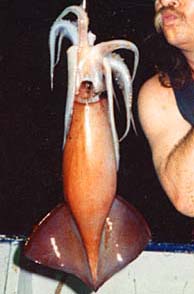
Mexican Sportfishing Regulations:
Some Interesting Surprises
![]()
|
Bernard R. Thompson's booklet of Mexican fishing regulations, and a forbidden delicacy. |
AN ACTUAL READING OF MEXICO'S SPORTFISHING RULES AND REGULATIONS
CAN SOMETIMES HAVE YOU SCRATCHING YOUR HEAD
Sept. 6, 2000, by Gene Kira:
How many of us have ever bothered to read the actual Mexican sportfishing regulations? I must confess: until a few months ago, all I had ever read was the little one-page sheets handed out by the Mexican Department of Fisheries. The thought of reading tons of legal stuff written in Spanish by a bunch of Mexican bureaucrats and lawyers was just too painful to contemplate. I let it slide for about 35 years.
However, I was recently jogged out this state of blissful ignorance by a little booklet written by Bernard R. Thompson, who runs the international consulting firm of MIRA Associates. Simply put, Thompson's booklet gives you a direct English translation of the most pertinent parts of Mexican law that apply to sportfishing. This booklet, titled "Mexico, Sportfishing Regulations, English, Spanish," is only 24 small pages long, and only 14 pages are in English. Just right, if you ask me.
|
|
Thompson's thoughtful editing and translating make it easy for anyone to find out what Mexican law actually says, and his booklet contains some interesting points and a couple of surprises for us tourist anglers. Here's a sample of some key items from Thompson's booklet:
1. The catching of "fish" only is allowed. Specifically prohibited are "crustaceans," "mollusks," "marine mammals," "reptiles" and "amphibians." No surprises there. We all know that we're not supposed to take lobsters and abalone, for instance. But, if you interpret this section literally, it also means you can't take squid, which is a type of mollusk. That is a surprise.
2. "A permit will not be required to engage in this activity [sportfishing] from land..." This provision has surfaced in the printed handouts often enough to be known by most old-timers. However, I have been asked to show my license on several occasions while shore fishing. I would ignore this section. Get a fishing license.
3. Section 4.6.6 is a mind-boggler. Chumming with live bait is prohibited except during "authorized" fishing tournaments. All live bait thrown into the water must have a hook in it. No kidding.
4. Section 4.6.5 says live bait can only be used to catch your first two fish of the day. After that, only dead bait is allowed. No kidding.
5. There are even some interesting notes in the well-plowed area of bag limits. The overall limit is 10 fish per day, of course, with a maximum of five fish of any single species. The limit is only one fish per day on marlin, sailfish, swordfish and shark. A one-fish limit of these species counts as five fish toward your overall limit. The limit is two fish per day for tarpon, dorado or roosterfish, and this also counts as five fish toward your overall limit. This means, if I interpret it correctly, that if you keep a blue marlin and two dorado, you are done for the day, no tuna, no cabrilla, no nothing (you may continue to catch-and-release).
|
|
6. You must not fish within 250 meters (271 yards) of swimming beaches or commercial fishing boats.
7. Spearfishing is allowed only while breath-hold skin diving. No fishing with scuba gear allowed. The spearfishing limit is five fish, regardless of species.
8. You may not fillet your fish aboard the boat that was used to catch it.
7. For bottom fishing and making bait, a maximum of four hooks is allowed on your line, no multiple-point hooks.
9. There are several references to minimum size requirements for billfish and other species, although those requirements are not specified.
10. The use of lights to attract fish is specifically prohibited, not just to attract "large quantities of fish."
11. The only prohibited fish species is the endangered totoaba, Cynoscion macdonaldi.
Some of these rules are generally known to the Baja sportfishing community. Some are not. Many of them are ignored, most notably the crazy regulations on the use of live bait, and the implied prohibition against catching squid.
Traditionally, Mexican inspectors have been lenient in allowing tourists to take such things as clams when it's "only for personal consumption." However, that has become very risky as enforcement has been steadily tightened in recent years, especially with regard to such economically lucrative species as lobster and abalone. Interestingly, Thompson's book makes no mention about "for personal consumption allowed." So watch it. This important booklet should be required reading for all of us who go fishing in Mexico.
(Related Mexico articles and reports may be found at Mexfish.com's main Mexico information page. See weekly fishing news, photos, and reports from the major sportfishing vacation areas of Mexico including the Mexico area in "Mexico Fishing News.")
MEXICO FISHING INFO MEXICO FISHING INFO "WEEKLY MEXICO FISHING NEWS" FISH PHOTO GALLERY

